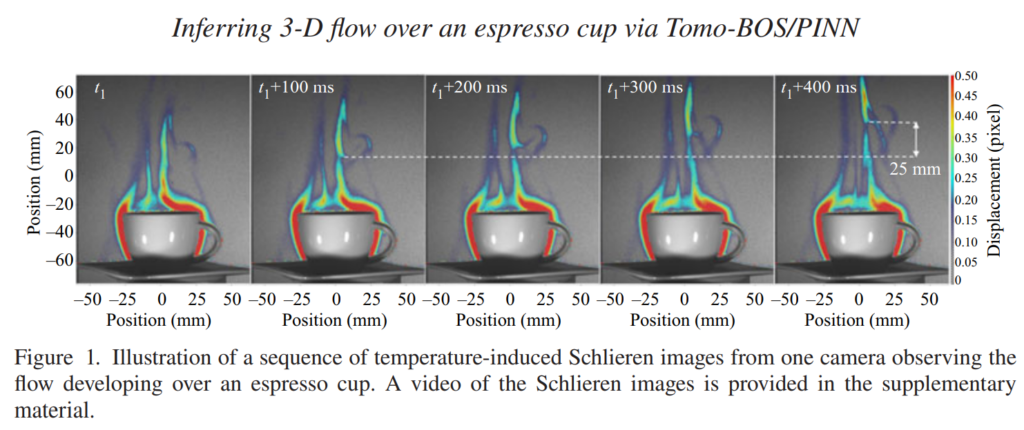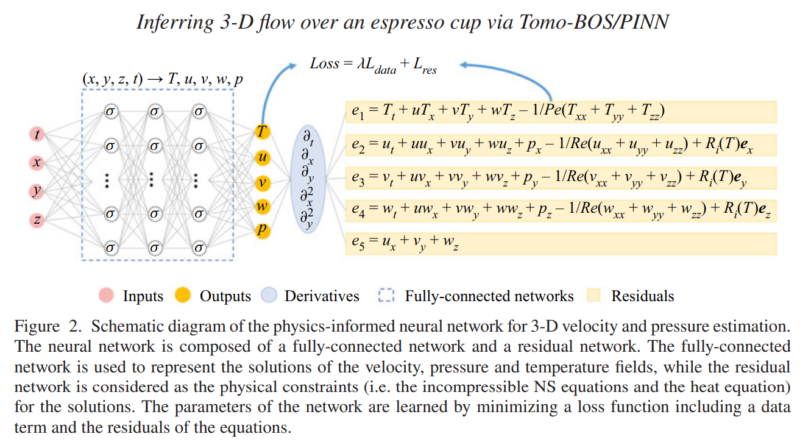Revolutionizing Fluid Dynamics: Integrating Physics-Informed Neural Networks with Tomo-BOS for Advanced Flow Analysis
Fluid dynamics plays a crucial role in various fields, including aerospace engineering, automotive design, and environmental studies. Understanding and analyzing fluid flows are essential for optimizing designs, predicting performance, and improving efficiency. Traditional methods for flow analysis, such as Particle Image Velocimetry (PIV) and Laser-Induced Fluorescence (LIF), have limitations in terms of cost, flexibility, and the ability to provide complete velocity and pressure fields. However, recent advancements in machine learning and imaging techniques have opened up new possibilities for revolutionizing fluid dynamics.
One such groundbreaking approach is the integration of Physics-Informed Neural Networks (PINNs) with Tomographic Background Oriented Schlieren (Tomo-BOS) imaging. PINNs combine the power of neural networks with the physical principles governing fluid flows, while Tomo-BOS provides three-dimensional velocity field reconstructions from experimental data. This integration has the potential to advance flow analysis by accurately inferring complete 3D velocity and pressure fields from limited experimental data.
🔥Explore 3500+ AI Tools and 2000+ GPTs at AI Toolhouse
Background on Tomo-BOS and Its Challenges
Background Oriented Schlieren (BOS) imaging is a widely used technique for visualizing and quantifying fluid flow. It relies on the distortion of objects in a density-varying medium due to light refraction. By capturing sequential images and applying digital image correlation or optical flow algorithms, researchers can analyze the flow patterns. However, quantifying complete velocity and pressure fields from BOS images remains a challenging task. Existing algorithms, mostly based on cross-correlation, provide sparse velocity vectors optimized for PIV. Direct pressure estimation requires additional methods. Furthermore, the reconstruction of three-dimensional velocity fields from Tomo-BOS is an open area in experimental fluid mechanics [7].
The Integration of Physics-Informed Neural Networks (PINNs)
Researchers from the Division of Applied Mathematics at Brown University, in collaboration with LaVision GmbH and LaVision Inc., have developed a pioneering method that integrates Physics-Informed Neural Networks (PINNs) with Tomo-BOS for advanced flow analysis [7]. PINNs combine the power of neural networks with the governing equations of fluid flow, enabling seamless integration of fluid flow physics and experimental data.

The PINN algorithm functions as a data assimilation technique, predicting velocity and pressure fields by analyzing visualization data across a spatio-temporal domain. Unlike conventional data assimilation methods, which rely on accurate initial guesses for velocity and pressure conditions, PINNs do not require such information. The trainable variables in a PINN are the parameters of the neural network, simplifying the implementation and eliminating the need to specify initial and boundary conditions for velocity or pressure. This flexibility makes PINNs a promising tool for advanced flow analysis [7].
Advantages of Integrating PINNs with Tomo-BOS
By integrating PINNs with Tomo-BOS, researchers can overcome the limitations of traditional methods and enhance flow analysis. Here are some key advantages of this integration:
1. Complete 3D Velocity and Pressure Fields
The integration of PINNs with Tomo-BOS enables the accurate inference of complete 3D velocity and pressure fields from limited experimental data. Unlike traditional methods that provide sparse velocity vectors, this approach offers a comprehensive understanding of fluid flows, allowing for more accurate predictions and optimizations.
2. Seamless Integration of Physics and Experimental Data
PINNs seamlessly integrate the governing equations of fluid flow with experimental data, bridging the gap between theory and practice. By combining the power of neural networks with the physics of fluid dynamics, researchers can enhance their understanding of complex flow phenomena and make more informed decisions.
3. Elimination of Initial and Boundary Conditions
Traditional flow analysis methods heavily rely on accurate initial and boundary conditions for velocity and pressure. However, PINNs remove this requirement by training the neural network parameters directly. This simplifies the implementation process and allows for more flexibility in analyzing different flow scenarios.
4. Versatility for Different Fluid Mechanics Problems
The integration of PINNs with Tomo-BOS offers versatility in analyzing various fluid mechanics problems. Whether it’s flow over an espresso cup or more complex flows in aerospace or automotive applications, this approach can provide valuable insights and accurate predictions.
Future Implications and Promising Directions
The integration of Physics-Informed Neural Networks with Tomo-BOS represents a significant advancement in fluid dynamics. By leveraging the power of machine learning and imaging techniques, researchers can revolutionize flow analysis and gain a deeper understanding of fluid flows. This integration opens up numerous possibilities for optimizing designs, predicting performance, and improving efficiency in various industries.
As research in this field progresses, it holds the potential to refine the accuracy and efficiency of flow analysis techniques. Furthermore, the combination of PINNs with other imaging and sensing technologies may further enhance our ability to analyze complex flow phenomena.
In conclusion, the integration of Physics-Informed Neural Networks with Tomo-BOS is revolutionizing fluid dynamics. This approach enables the accurate inference of complete 3D velocity and pressure fields from limited experimental data, seamlessly integrating physics and experimental data. The elimination of initial and boundary conditions simplifies the implementation process, while the versatility of this approach holds promise for various fluid mechanics problems. With ongoing research and advancements, the future of flow analysis looks brighter than ever.
Check out the Paper. All credit for this research goes to the researchers of this project. Also, don’t forget to follow us on LinkedIn. Do join our active AI community on Discord.
If you like our work, you will love our Newsletter 📰




